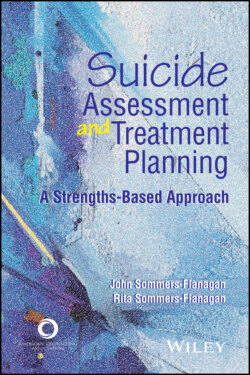Читать книгу Suicide Assessment and Treatment Planning - John Sommers-Flanagan - Страница 27
Suicide Treatment Models
ОглавлениеIn the book Brief Cognitive-Behavioral Therapy for Suicide Prevention, Bryan and Rudd (2018) described and assessed three distinct suicide intervention models. The risk factor model emphasizes correlates and predictors of suicidal ideation and behavior. Practitioners who follow the risk factor model aim their treatments toward reducing known risk factors and increasing protective factors. Unfortunately, a dizzying array of risk factors exist; some are relatively unchangeable; and in a large, 50-year, meta-analytic study, researchers concluded that risk factors, protective factors, and warning signs are largely inaccurate and not useful (Franklin et al., 2017). Consequently, treatments based on the risk factor model are not in favor.
The psychiatric model focuses on treating psychiatric illnesses to reduce or prevent suicidality. The presumption is that clients experiencing suicidality should be treated for the symptoms linked to their diagnosis. Clients with depression should be treated for depression, clients diagnosed with posttraumatic stress disorder should be treated for trauma, and so on. Bryan and Rudd (2018) noted that “accumulating evidence has failed to support the effectiveness of this conceptual framework” (p. 4).
The final model is the functional model. Bryan and Rudd (2018) wrote, “According to this model, suicidal thoughts and behaviors are conceptualized as the outcome of underlying psychopathological processes that specifically precipitate and maintain suicidal thoughts and behaviors over time” (p. 4). The functional model targets suicidal thoughts and behaviors within the context of the individual’s history and present circumstances. Bryan and Rudd emphasized that the superiority of the functional model is “well established” (pp. 5–6; they cited a meta-analysis showing that functional approaches are significantly superior to the psychiatric model for suicide risk reduction; Tarrier et al., 2008).
Our approach differs from the functional model in several ways. Given our wellness and strengths-based orientation, we studiously avoid presuming that suicidality is a psychopathological process. Instead, consistent with social constructionist philosophy, we believe that locating psychopathological processes within clients risks exacerbating and perpetuating psychopathology as an internalized phenomenon (Hansen, 2015; Lyddon, 1995). From a constructionist perspective, client problems (including suicidality) are not necessarily within the self but instead are viewed as constructed by individuals and social groups. In addition to our wellness, strengths-based, constructionist foundation, we rely on an integration of robust suicide theory and practice (we rely on works from Jobes, Joiner, Klonsky & May, Linehan, O’Connor, and Shneidman). We also embrace parts of the functional model, especially the emphasis on individualized contextual factors that can increase or decrease risk. Overall, our goal is to provide counseling practitioners with a practical and strengths-based model for working effectively with clients and students who are suicidal.
